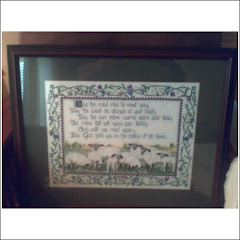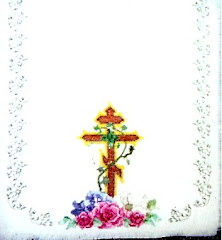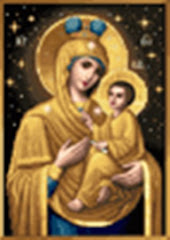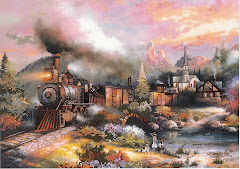
I seem to be getting myself in deeper and deeper -- Suzanne was wondering how I keep track of all those different colors. This is an earlier photo that shows it best.
First, you grid. Some people actually have the patience to stitch a 10 x 10 grid onto their fabric. I don't; I work the first ten stitches in any given row, then use a washable dress-pattern marker to plot the grids. And as you can see from this photo, I only do the grid I'm working on, and leave little "tails" of marker at the end so that when I'm finished with that grid, I can lay out the next grid and know that it will be 10 x 10.
Having done that, I am also fanatical about marking off each row of ten stitches as I work it. I really would go crazy otherwise.
And the final thing I do to keep track of all the colors and threads -- and the reason I chose this photo -- is that I "park" stitches. I only work ten stitches at a time, straight down the row. Sometimes a row will contain as few as three colors, other times, every single stitch is a different color. When I work a stitch, I look ahead in that row to see where the color will occur next, and bring the needle up in that stitch. If it won't occur again in that row, I look ahead to the next row, and if I see that color symbol in the next row, I'll bring the needle up in that stitch and "park" the thread there until it's needed again. If it doesn't occur in the next row, I'll scan the entire grid to see where it shows up next.
Sometimes it doesn't occur again until much later in the project, and in that case, I do finish off the thread and wrap the leftover around the skein of floss, where it stays until I need it again. I finish off using something called a "pinhead stitch": Since cross-stitch fabric consists of little holes, you can bring the thread up in between two holes -- crosswise or lengthwise, according to the weave of the fabric -- and push the needle back down smack in the middle of the little square. Then you bring it back up on the other side of where you've made your "pinhead," and push it back down in the middle of the little square again. Then you pull it tightly. Once you get the hang of it, you can actually make the pinhead stitch nearly invisible, because it buries itself in the middle of the square.
To start threads, it depends on whether or not they're leftover from earlier working. If I have two strands left over from where they were worked before, I'll start with the pinhead stitch, too. If not, I cut an extra-long length, fold it in half, and push both ends through the eye of the needle; bring the thread up through the hole of the first stitch, but not all the way, and back down into the cross-point of the stitch (looks like / ). Then, as I'm bringing the thread back down, I guide it through the loop left hanging when I pulled the thread up, and then pull tight. It's called the "loop method" of starting. Some people frown on it because there is supposed to be a shiny side to thread and a dull side, and using the loop method means that you're working with both a shiny thread and a dull thread, so to speak. But I have never been able to distinguish which is which, so I just go on my merry way. Hey, it's my cross stitch. ;-)





1 comment:
Wow, Meg. I can tell you've become quite the master at this. It sounds complicated. I've never gotten into cross stitch, except for one or two small projects when I was a child. I guess I prefer making marks directly onto paper or wood or canvas and smearing them around to laying down tiny bits if color next to each other. I just don't have the patience for that. Give me a brush with one color, another brush with another color, smear them, blend them; and, presto, you have a whole area colored, blended, shaded. You have my admiration.
Post a Comment